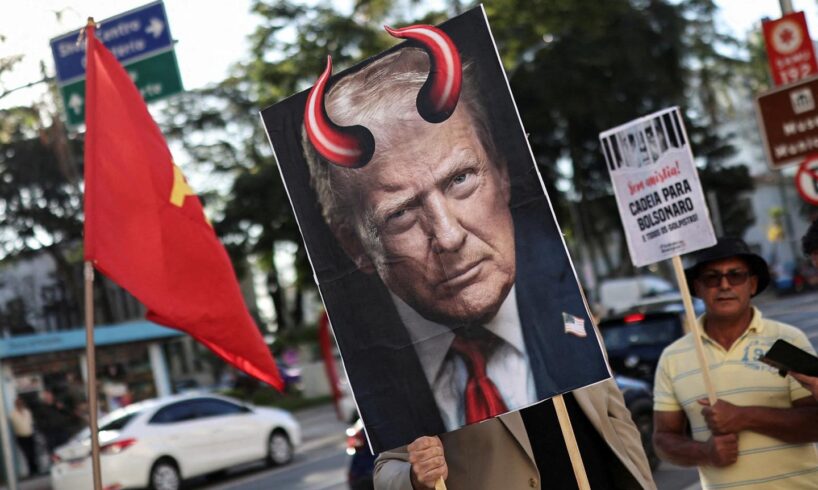
A demonstrator holds an image of US President Donald Trump with red horns during a protest against the tariffs on Brazilian products imposed by Trump, in São José dos Campos, Brazil, July 29, 2025. ROOSEVELT CASSIO / REUTERS
President Donald Trump ordered the reimposition of tariffs on dozens of trading partners on Thursday, July 31, his cornerstone strategy for reshaping global trade to benefit the US economy. However, in a minor reprieve, the White House said the measures will take effect in a week, not this Friday as previously expected.
A senior White House official said Thursday higher tariffs ordered by Trump would go into effect on August 7. The official said the delay was designed to ensure border and customs authorities have time to “implement” the new regime. The tariffs are a demonstration of raw economic power that Trump says will put US exporters in a stronger position while encouraging domestic manufacturing by keeping out foreign imports.
But the muscular approach has raised fears of inflation and other economic fallout in the world’s biggest economy. And with questions hanging over the effectiveness of bilateral trade deals already struck – including by the European Union and Japan – the outcome of Trump’s plan remains uncertain.
Trump’s new measures in an executive order raised duties on dozens of economies up to a 41% rate.
Read more Subscribers only Initial tariff impacts painful for auto, textile and chemical industries
Frantic negotiations
Most of these new tariff hikes were first announced in April when Trump slapped a minimum 10% levy on goods from almost every country in the world, citing unfair trade practices and US deficits. However, Washington then postponed implementation, amid a frantic series of negotiations, alongside announcements of new duties and deals with some partners.
Just Thursday, Trump announced he was delaying a tariff hike on products from the major US trading partner Mexico. The postponement by 90 days came after talks with his counterpart Claudia Sheinbaum. The 79-year-old Republican has made tariffs core to his protectionist brand of hard-right politics. On Thursday, he claimed that the US economy had “no chance of survival or success” without tariffs.
But the latest salvo came amid legal challenges against Trump’s use of emergency economic powers. On Thursday, the US Court of Appeals for the Federal Circuit heard arguments in cases brought against Trump’s blanket tariffs targeting different countries. And questions linger over the effectiveness of Trump’s grand plans, or even whether he will hold firm on his most drastic threats.
While Trump has touted a surge in customs revenues since the start of the year, economists warn the duties could fuel inflation. Proponents of his policy argue that its impact will be one-off, but analysts are awaiting further economic data to gauge for more persistent effects.
China is notably exluded
Among those who managed to strike deals with Washington were Vietnam, Japan, Indonesia, the Philippines, South Korea and the European Union. Britain also reached a pact with the United States, although it was not originally targeted by higher “reciprocal” tariffs.
Read more Subscribers only Tariffs: In France, even the prime minister criticizes the EU’s ‘submission’ to Trump
Washington did not finalize a deal with neighboring Canada, but Trump reached agreement with Mexico to maintain an existing 25% duty on its products.
Partner service
Learn French with Gymglish
Thanks to a daily lesson, an original story and a personalized correction, in 15 minutes per day.
Try for free
Canada, however, was slapped with duties of 35% in the Trump executive order. An exemption for goods entering the country under a North American trade pact remained in place, according to the White House. But transshipped goods to evade the 35% duty would face even higher levels.
Shipping containers are stacked at the Port of Los Angeles, California, on May 6, 2025. FREDERIC J. BROWN / AFP
Canada’s trade relations with the United States came under renewed threat after Prime Minister Mark Carney announced plans to recognize a Palestinian state at the UN General Assembly in September.
Notably excluded from the latest drama was China, which faces an August 12 deadline instead, when duties could bounce back to higher levels. Washington and Beijing had slapped tit-for-tat tariffs on each other’s goods, bringing them to triple-digit levels before both countries reached an agreement in May to temporarily lower these duties. The superpowers are now working toward extending their truce.





